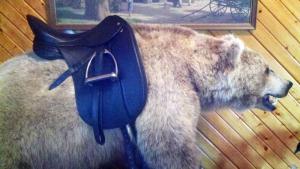By Terry Peiper, Fit Right Saddle Solutions
A few years ago, while I was working with a client and her horse, I observed the most remarkable change in another horse that was close by. It was a large busy stable with boarders and students coming and going. During the appointment, I had to walk past a horse and duck under the cross ties several times to get to the client's horse. The horse on the cross ties was friendly, curious, and totally relaxed as I passed by several times. He seemed to be looking for treats. Then a few minutes later, I did exactly the same thing, I passed the horse on the cross ties, same direction, same side, same student nearby with the same horses tied in the aisle further back behind him. This time, he pinned his ears, showed his teeth, turned his hip towards me and swished his tail. It was very dramatic and deliberate! That time, I was carrying a saddle.
I don’t know what upset me more: knowing that the horse must have had a horrible saddle experience for him to react so strongly or how the student reprimanded the horse and called him names for his behavior. I admit that in the past I may have reacted the same as the student, not because I did not care, but because I didn’t know then what I do know now.
At another evaluation, Logan, a big 10-year-old Thoroughbred-cross gelding was being held by a little girl. He was a perfect gentleman, standing almost like a statue in a halter class while I did the measuring and getting tracings of his back. But the minute I picked up the saddle off the saddle stand, Logan immediately started moving around, stomping his back feet, head up high, and wringing his tail. Realizing how unsafe this situation was for the little girl, an adult jumped in and grabbed the horse and shank with a chain. The adult then proceeded to tell me how this horse had a reputation for his poor ground manners. Logan's ground manners were flawless until the saddle appeared.
Since this was the horse I was evaluating, I found that his saddle was way too wide. There was no clearance on the sides or the top of the withers, which is probably what caused all the white hairs he had on the top of his withers. He was extremely sensitive all along his spinal ligament, from the withers all the way back to the lumbar. He had large shoulder holes and the bottom of his neck was over developed. During the riding portion of his evaluation, he was stiff to the right and had trouble picking up his right lead. He also was dragging his toes in the rear. Logan was in full work and had been in a show the day before I was there. He had a good quality saddle and a top of the line sheepskin pad, but no pad can fix a saddle that is too wide with a too wide tree angle.
Thankfully Logan improved with a better fitting saddle and no special pads, proving the saddle was causing him discomfort. Horses don't lie; they react and they communicate through their behavior. Since horses are hardwired to hide their pain, most put up with a lot before they speak up. It is the responsibility of the horseman to learn their language before any real damage is done.
If a horse with an otherwise kind personality turns into a bear when approached with a saddle, he is trying to communicate the only way he knows how: that the saddle might be causing pain. I keep referring to the horse as he, but of course your horse could be a she. Heaven help you if you are trying to ride a mare in pain! Some horses are more passive than others and will tolerate the pain either out of fear or have simply learned to shut down or block it out until they cannot hide it anymore. Sadly, sometimes a poor fitting saddle isn't noticed until there is serious damage done to the horse.
Horses communicate through their behavior. If your horse acts like a bear, becomes grouchy when the saddle appears, bites while being girthed up, won't stand for mounting, has trouble with leads, has trouble going downhill, refuses jumps, is anxious and hot headed, has unexplained lameness issues, requires repeated chiropractic care or injections, any of this behavior could be caused by your saddle. To prevent needless suffering and possible long term permanent damage, please check your saddle fit regularly and, if you are unsure that it fits properly, get some professional help. Doesn't your horse deserve to be comfortable?
“Spreading the word about proper saddle fit and how it affects our horse’s behavior, performance and ultimately the health of horse and rider.”
A few years ago, while I was working with a client and her horse, I observed the most remarkable change in another horse that was close by. It was a large busy stable with boarders and students coming and going. During the appointment, I had to walk past a horse and duck under the cross ties several times to get to the client's horse. The horse on the cross ties was friendly, curious, and totally relaxed as I passed by several times. He seemed to be looking for treats. Then a few minutes later, I did exactly the same thing, I passed the horse on the cross ties, same direction, same side, same student nearby with the same horses tied in the aisle further back behind him. This time, he pinned his ears, showed his teeth, turned his hip towards me and swished his tail. It was very dramatic and deliberate! That time, I was carrying a saddle.
I don’t know what upset me more: knowing that the horse must have had a horrible saddle experience for him to react so strongly or how the student reprimanded the horse and called him names for his behavior. I admit that in the past I may have reacted the same as the student, not because I did not care, but because I didn’t know then what I do know now.
At another evaluation, Logan, a big 10-year-old Thoroughbred-cross gelding was being held by a little girl. He was a perfect gentleman, standing almost like a statue in a halter class while I did the measuring and getting tracings of his back. But the minute I picked up the saddle off the saddle stand, Logan immediately started moving around, stomping his back feet, head up high, and wringing his tail. Realizing how unsafe this situation was for the little girl, an adult jumped in and grabbed the horse and shank with a chain. The adult then proceeded to tell me how this horse had a reputation for his poor ground manners. Logan's ground manners were flawless until the saddle appeared.
Since this was the horse I was evaluating, I found that his saddle was way too wide. There was no clearance on the sides or the top of the withers, which is probably what caused all the white hairs he had on the top of his withers. He was extremely sensitive all along his spinal ligament, from the withers all the way back to the lumbar. He had large shoulder holes and the bottom of his neck was over developed. During the riding portion of his evaluation, he was stiff to the right and had trouble picking up his right lead. He also was dragging his toes in the rear. Logan was in full work and had been in a show the day before I was there. He had a good quality saddle and a top of the line sheepskin pad, but no pad can fix a saddle that is too wide with a too wide tree angle.
Thankfully Logan improved with a better fitting saddle and no special pads, proving the saddle was causing him discomfort. Horses don't lie; they react and they communicate through their behavior. Since horses are hardwired to hide their pain, most put up with a lot before they speak up. It is the responsibility of the horseman to learn their language before any real damage is done.
If a horse with an otherwise kind personality turns into a bear when approached with a saddle, he is trying to communicate the only way he knows how: that the saddle might be causing pain. I keep referring to the horse as he, but of course your horse could be a she. Heaven help you if you are trying to ride a mare in pain! Some horses are more passive than others and will tolerate the pain either out of fear or have simply learned to shut down or block it out until they cannot hide it anymore. Sadly, sometimes a poor fitting saddle isn't noticed until there is serious damage done to the horse.
Horses communicate through their behavior. If your horse acts like a bear, becomes grouchy when the saddle appears, bites while being girthed up, won't stand for mounting, has trouble with leads, has trouble going downhill, refuses jumps, is anxious and hot headed, has unexplained lameness issues, requires repeated chiropractic care or injections, any of this behavior could be caused by your saddle. To prevent needless suffering and possible long term permanent damage, please check your saddle fit regularly and, if you are unsure that it fits properly, get some professional help. Doesn't your horse deserve to be comfortable?
“Spreading the word about proper saddle fit and how it affects our horse’s behavior, performance and ultimately the health of horse and rider.”








